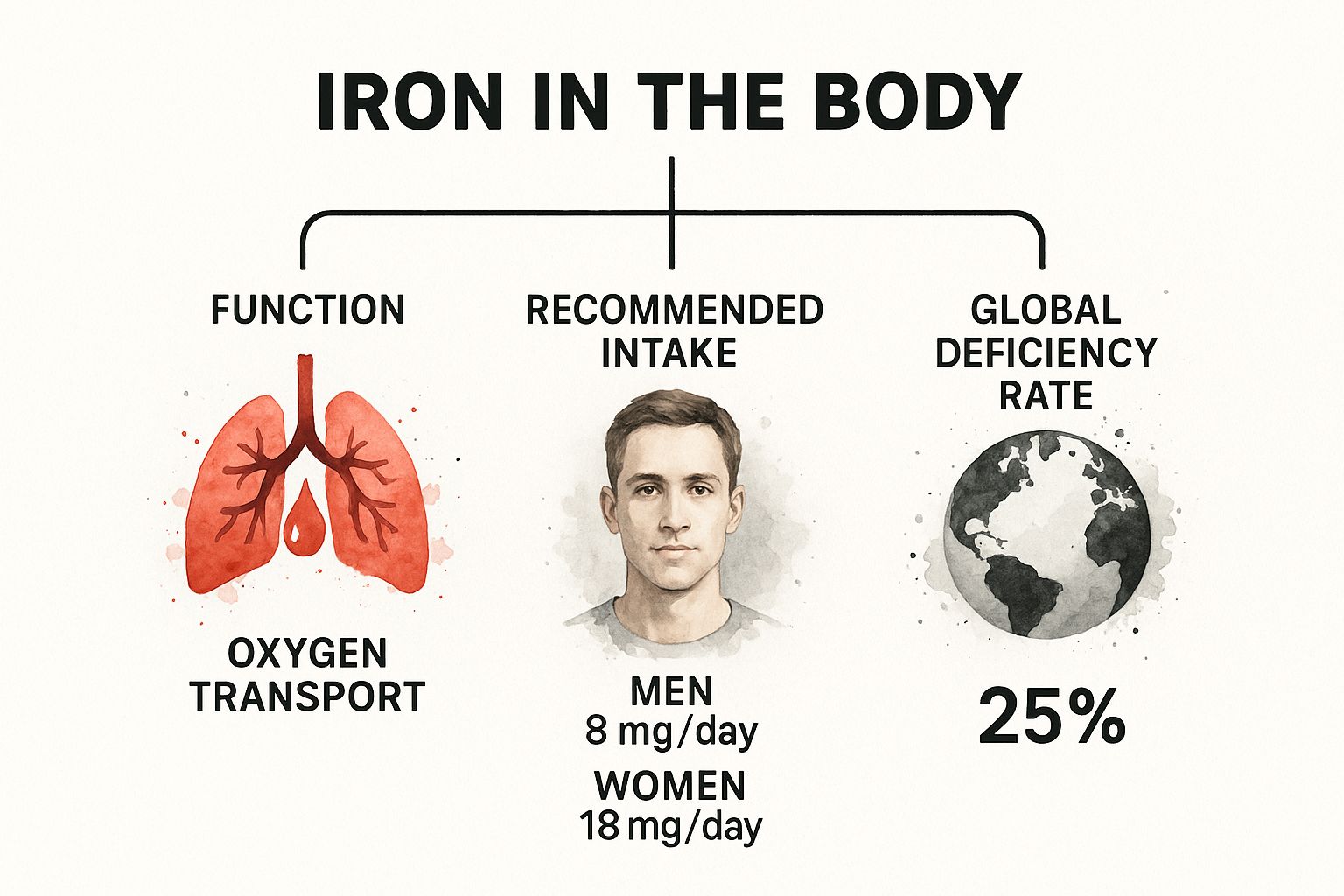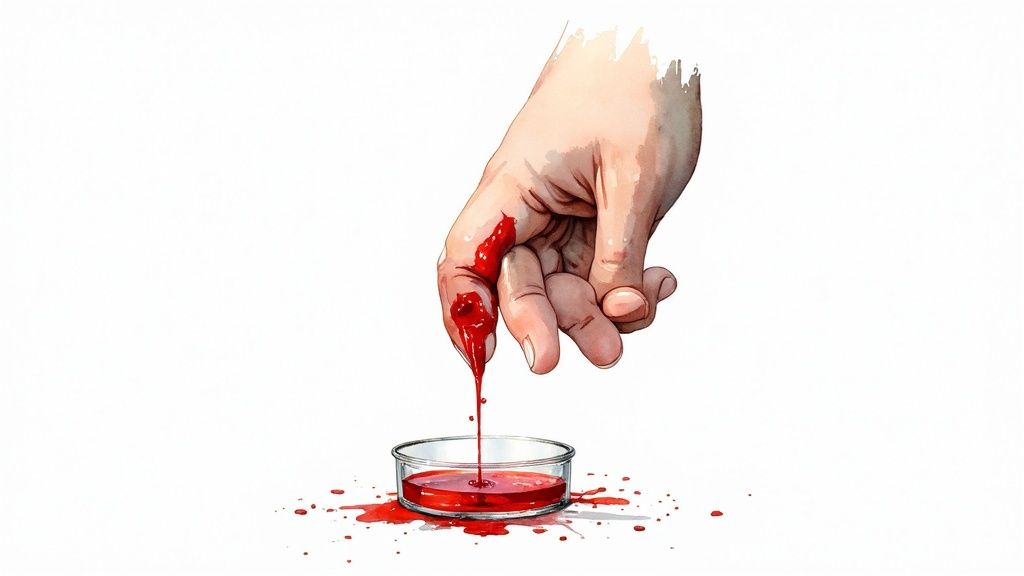Low iron levels typically stem from one of four core issues: insufficient dietary intake, poor absorption, blood loss, or an increased physiological demand (like pregnancy). But truly understanding what causes low iron levels is more than a simple checklist. It's about recognizing how this essential mineral fuels your long-term health, vitality, and potential for a longer, healthier life.
Why Iron Is Your Engine for a Longer, Healthier Life
Imagine your body as a high-performance engine designed for the long haul. It requires premium fuel and meticulous maintenance to function optimally for decades. In this analogy, iron is the critical component ensuring that every part works in perfect harmony. It's the cornerstone of haemoglobin, the protein within your red blood cells tasked with the single most vital job in your body: transporting oxygen from your lungs to every single cell.
When your iron levels are optimal, your engine runs smoothly. Your brain receives the oxygen needed for cognitive sharpness, your muscles have the fuel for daily activity and exercise, and your immune system is primed to defend against threats. This consistent cellular energy is the foundation of longevity. It’s not just about overcoming today's fatigue; it's about building a resilient system that can navigate the ageing process with grace and strength.
The Longevity Connection
Maintaining optimal iron levels is a powerful, proactive investment in your future self.
When iron is chronically low, your body must work harder to achieve the same output, leading to systemic wear and tear. Over many years, this can manifest as persistent fatigue, cognitive decline, and a compromised immune system—all factors that can significantly diminish your healthspan and quality of life as you age.Maintaining adequate iron is less about fixing a temporary problem and more about fuelling your body for the long haul. It supports everything from cognitive sharpness in your later years to the physical stamina needed to stay active and engaged with life.
The infographic below highlights iron's central role, detailing our daily needs and revealing how many people are falling short—a gap that directly impacts our long-term health potential.

This visual underscores a critical reality: with 25% of the global population affected by iron deficiency, this is a widespread issue that directly compromises our longevity. By understanding the causes and prioritising this mineral, you take a decisive step toward keeping your internal engine running optimally for decades to come.
Primary Causes of Low Iron at a Glance
To clarify how these factors impact your long-term health, here’s a summary of the main culprits behind low iron levels.
| Cause Category | Specific Examples | Impact on Longevity |
|---|---|---|
| Dietary Intake | Vegan/vegetarian diets, restrictive eating patterns, diets low in iron-rich foods like red meat and leafy greens. | Insufficient raw material for haemoglobin production leads to a gradual depletion of iron stores, undermining cellular energy and long-term vitality. |
| Poor Absorption | Celiac disease, Crohn's disease, gastric bypass surgery, or consuming high amounts of iron inhibitors (e.g., tannins in tea). | Even with adequate intake, the body cannot absorb and utilise iron, compromising cellular repair and resilience over time. |
| Increased Demand | Pregnancy, infancy and childhood growth spurts, intense athletic training. | The body's need for iron outpaces its supply, creating a deficit that can compromise long-term health if not addressed proactively. |
| Blood Loss | Heavy menstrual periods, internal bleeding (e.g., from ulcers or polyps), frequent blood donations, or significant injury. | Direct loss of iron from the body depletes stores, forcing the cardiovascular system to work harder and increasing long-term strain. |
Each of these pathways can lead to an iron deficit that affects your daily function and your future health. Identifying which one applies to you is the first step toward reclaiming your energy and investing in your longevity.
The Four Main Reasons Your Iron Might Be Low

Investigating what causes low iron levels is like solving a puzzle. The clues almost invariably point to one of four key areas: your diet, your body's absorption efficiency, your current physiological demands, or any ongoing blood loss. By examining each, you can pinpoint why your vitality might be compromised.
It's important to remember that these factors often work in tandem, creating a perfect storm for iron deficiency. Let's dissect each of these core reasons to understand how they can silently drain your body's essential iron reserves, impacting your long-term health.
Dietary Gaps and Iron Sources
The most straightforward cause of low iron is not consuming enough through your diet. Food is the sole source of this mineral, and if your dietary supply line is weak, your internal reserves will inevitably diminish. However, it's not merely the quantity of iron you consume; the type of iron is equally critical for long-term sufficiency.
Your body absorbs iron from animal products (haem iron) far more efficiently than iron from plants (non-haem iron). Haem iron, found in red meat, poultry, and fish, is highly bioavailable. In contrast, non-haem iron—from sources like spinach, lentils, and beans—requires more effort from your gut to be absorbed and utilised.
A diet can appear healthy, rich in salads and whole grains, yet be functionally deficient in easily absorbable iron. This is why even health-conscious individuals can develop a deficiency over time, slowly undermining their long-term vitality.
This doesn't mean a plant-based diet guarantees deficiency. It simply requires a more strategic approach, ensuring you not only consume iron-rich foods but also pair them with nutrients that enhance absorption, like vitamin C, to support your health for years to come.
Roadblocks in Iron Absorption
Sometimes, the problem isn't your diet but your body's ability to process it. You could be consuming ample iron-rich foods, but if your digestive system fails to absorb it effectively, it remains useless. This is a significant challenge for individuals with certain health conditions that impact long-term gut health.
Gut-related conditions are often the primary offenders:
- Coeliac disease: Damage to the small intestine lining severely impairs its ability to absorb nutrients, including iron.
- Crohn's disease: Chronic inflammation associated with this condition can directly interfere with the absorption process.
- Gastric bypass surgery: Altering the digestive tract reduces the surface area available for nutrient uptake.
Even without a diagnosed condition, chronic use of antacids can lower stomach acid levels, which are essential for preparing iron for absorption in the gut, creating a subtle but long-term drain on your stores.
Periods of Increased Demand
Certain life stages dramatically increase your body's iron requirements, often exceeding what a standard diet can supply. These high-demand periods are a major cause of iron deficiency and require proactive management to protect long-term health.
Pregnancy is the quintessential example. A woman's blood volume can expand by nearly 50% to support the foetus, creating an immense demand for iron to produce additional red blood cells. In the UK, an estimated 23% of pregnant women experience iron deficiency anaemia, highlighting this vulnerability. You can find more insights about iron deficiency in the UK population.
Rapid growth spurts during infancy and adolescence are also critical periods. The body is actively building new tissues and expanding its blood supply, demanding a continuous, high-level source of iron. This makes children and teenagers particularly susceptible to deficiencies that can impact their development.
Chronic and Hidden Blood Loss
The final major cause is losing iron more rapidly than you can replace it, which occurs with any form of blood loss. While a major injury is an obvious cause, it's the slow, chronic, and often hidden bleeds that are more likely to deplete iron stores over time, creating a long-term health risk.
For many women, heavy menstrual periods represent a significant and recurring source of iron loss each month. Other, less obvious causes include:
- Stomach ulcers: These can cause slow, persistent bleeding within the digestive tract.
- Gastrointestinal issues: Conditions like ulcerative colitis can also result in internal bleeding.
- Regular use of NSAIDs: Painkillers such as ibuprofen can sometimes irritate the stomach lining, causing bleeding.
Because this type of blood loss is often gradual, it may go unnoticed until the classic symptoms of iron deficiency—such as profound fatigue and weakness—become too severe to ignore.
Who Is Most at Risk for Iron Deficiency?

While anyone can experience low iron levels, the risk is not distributed equally. Certain life stages, biological factors, and lifestyle choices can predispose some individuals to deficiency. Understanding your personal risk is the first step toward proactive health management and preserving your long-term vitality.
Think of it as an engine under constant strain—it simply requires more resources. Similarly, certain groups have a higher biological demand for iron. This isn't a weakness but a matter of supply and demand. By identifying these groups, we can better understand what causes low iron levels in different populations.
Women of Reproductive Age
Menstruating women are consistently one of the groups most susceptible to iron deficiency. The simple reality is that monthly blood loss equates to a steady loss of iron. If this iron is not adequately replaced through diet, the body's reserves can slowly diminish, leading to fatigue and reduced performance.
A comprehensive report from the Scientific Advisory Committee on Nutrition (SACN) revealed that iron deficiency anaemia is particularly prevalent among girls aged 15 to 18 and women between 35 and 49. This is a direct consequence of menstrual bleeding, making iron a critical nutrient for women's long-term health. You can explore the full report on iron and health from SACN.
Pregnancy also significantly increases the body's demand for iron. The creation of new life requires a substantial expansion of blood volume and red blood cells, placing immense pressure on the mother's iron stores to support both herself and her developing baby.
Children and Older Adults
Periods of rapid growth are incredibly demanding on iron stores, placing young children at high risk. During infancy and toddlerhood, their bodies are working overtime to build muscle, expand circulatory systems, and develop their brains—all processes requiring a constant, reliable supply of iron. Combined with potential picky eating habits, a shortfall can easily occur.
At the other end of the lifespan, older adults face their own set of challenges that increase their risk:
- Reduced Appetite: A natural decline in appetite often leads to lower overall food intake.
- Poorer Absorption: As we age, our digestive systems can become less efficient at extracting iron from food.
- Chronic Health Conditions: Certain health issues and their medications can interfere with the body's ability to use iron.
Individuals with Specific Diets or Lifestyles
Your lifestyle and dietary choices also play a significant role. If you follow a vegan or vegetarian diet, you must be particularly mindful of your iron intake. While it's entirely possible to obtain sufficient iron from plant-based sources, it requires careful planning due to the lower bioavailability of this type of iron (non-haem).
An individual's risk is often a combination of biology and behaviour. A young female athlete, for example, might face a triple threat: menstrual blood loss, a restrictive diet for performance, and the heightened iron demands of intense training.
Athletes, especially endurance athletes like runners, are another group requiring close attention. They lose iron through sweat, minor gastrointestinal bleeding, and the accelerated breakdown of red blood cells associated with intense physical activity. For anyone in this category, it's beneficial to learn more about the specific link between iron deficiency in runners and how to manage it for sustained performance and long-term health.
Decoding the Diagnosis: Why Low Iron Is Often Missed
Have you ever felt persistently exhausted and mentally foggy, only to be told your blood tests are 'normal'? This frustrating experience is common and often stems from a gap in how low iron is diagnosed. The issue isn't the test's accuracy but what is being measured and how the results are interpreted in the context of long-term health.
Standard blood work often focuses solely on haemoglobin, the protein that carries oxygen. If your haemoglobin drops too low, you are diagnosed with anaemia. However, anaemia is the final stage of a prolonged process. You can suffer from the debilitating symptoms of low iron for months, or even years, before it progresses to clinical anaemia.
The Difference Between Low Stores and Anaemia
Think of your body's iron supply like a financial system. Ferritin represents your savings account—it's the iron stored for future needs. Haemoglobin is like your current account, used for the daily, essential business of oxygen transport.
Many initial tests only check your current account (haemoglobin). If it appears adequate, the issue may be dismissed. A thorough investigation, however, must assess your savings (ferritin). It is entirely possible for your ferritin levels to be critically low, meaning you are running on empty, long before your haemoglobin drops enough to trigger an anaemia diagnosis.
This is the 'silent burden' of iron deficiency. Your body is incredibly resourceful and will protect its oxygen-carrying capacity at all costs. It will drain your iron stores completely before allowing your haemoglobin levels to fall. By the time anaemia shows up, you've likely been struggling for a very long time, compromising your long-term health.
Why Your Symptoms Are a Crucial Clue for Longevity
Symptoms like fatigue, brain fog, hair loss, and poor exercise recovery are your body’s early warning system, indicating that your iron stores are dangerously low. It is vital to heed these signals, even if a basic blood count appears normal. For a complete picture, a comprehensive test that includes ferritin is essential.
Research supports this, revealing it as a widespread issue, particularly for women. A large-scale analysis of health-conscious UK adults found that while the overall anaemia rate was 6%, it rose to nearly 10% in females. More tellingly, absolute iron deficiency (low ferritin) affected a staggering 31.6% of women. This demonstrates how many are living with depleted iron stores without a formal diagnosis. You can explore the full UK data on iron deficiency and its silent burden.
Understanding the difference between these markers empowers you to have a more informed discussion with your healthcare provider. If you suspect low iron is undermining your health, specifically requesting a ferritin test could be the key to unlocking your vitality.
For a deeper understanding of these metrics, review our guide on understanding your full blood count explained. This knowledge is crucial for advocating for your long-term health.Your Action Plan for Restoring Iron Levels
Identifying why your iron is low is the first step, but taking decisive action is how you will reclaim your energy and safeguard your long-term health. Restoring your iron levels isn't about a single quick fix; it's about implementing a sustainable strategy that combines intelligent dietary choices with professional guidance when necessary.
Think of this as a two-pronged approach. First, we will focus on optimising iron intake from your diet. Then, we will discuss when to seek professional help with supplementation, ensuring it is done safely and effectively for long-term benefit.
Power Up Your Plate with Iron-Rich Foods
Your diet is the first and most important line of defence for maintaining healthy iron levels. The key is to consistently integrate high-quality iron sources into your daily meals.
Here are some of the top choices available in the UK:
- Powerful Animal Sources (Haem Iron): This is the most bioavailable form of iron. Prioritise lean red meats like beef and lamb, organ meats such as liver, and the darker meat from poultry. Oily fish like sardines and mackerel are also excellent choices.
- Effective Plant-Based Sources (Non-Haem Iron): While less easily absorbed, this type is still vital. Load your plate with dark leafy greens like kale and spinach, lentils, chickpeas, and beans. Fortified breakfast cereals, dried apricots, and pumpkin seeds are also great for boosting your levels.
Maximise Absorption with Smart Pairings
It's not just what you eat, but what you eat it with. Simple meal adjustments can significantly increase the amount of iron your body absorbs, directly impacting your long-term health.
The most effective strategy is to pair iron-rich foods with a source of Vitamin C. Vitamin C acts as a key, unlocking non-haem iron and making it more available to your body. Squeezing lemon juice over a spinach salad or having a small glass of orange juice with fortified cereal can dramatically boost absorption.
Conversely, some common foods can inhibit iron absorption. The tannins in tea and coffee, as well as the calcium in dairy products, can interfere with iron uptake. It's best to avoid consuming these with your main meals—try to leave at least an hour's gap to allow your body to absorb the iron from your food effectively.
When to Consider Professional Guidance and Supplementation
While a nutrient-dense diet is foundational, it is sometimes insufficient to correct a significant deficiency, especially if an underlying issue like blood loss or malabsorption is present.
If you are experiencing persistent symptoms, it is time to consult a professional. A comprehensive blood test for vitamin and mineral deficiency is the only way to get a clear picture of your iron stores, particularly your ferritin levels.
Supplements should only be taken under the guidance of a healthcare professional, as excessive iron can be toxic. They can recommend the appropriate dosage and type of iron for your specific needs. For certain groups, such as pregnant women, selecting the best iron supplement for pregnancy is critical, and expert advice is essential.
By combining a targeted diet with professional oversight, you can create a powerful, personalised plan to restore your iron levels and revitalise your health for the long term.
Common Questions About Low Iron Levels

When it comes to our health, questions are natural, especially when trying to understand what causes low iron levels and its implications for our long-term vitality. Here are clear, practical answers to some of the most common queries to guide your health journey.
From the subtle effects of stress to the realities of plant-based diets, getting accurate information is the first step toward making confident choices for a longer, healthier life.
Can Stress Cause Low Iron Levels?
While stress doesn't directly deplete your iron stores, it acts as a significant accomplice. Chronic stress can trigger gut inflammation and disrupt your digestive system, making it much harder for your body to absorb iron from food. This malabsorption can, over time, lead to a deficiency.
Furthermore, stress often leads to poor dietary choices. We may opt for convenient, low-nutrient foods or skip meals altogether, reducing our iron intake. Therefore, managing stress is a crucial, often overlooked, strategy for maintaining optimal iron levels and supporting long-term health.
How Long Does It Take to Raise Iron Levels?
Restoring your iron reserves is a marathon, not a sprint. The timeline depends on the cause of the deficiency, its severity, and the treatment approach.
- Through Diet Alone: For a mild deficiency, you may start to feel better within a few weeks of consistent dietary changes. However, fully replenishing your body's iron savings account (ferritin) to an optimal level for longevity can take three to six months.
- With Oral Supplements: If prescribed by a professional, you will likely notice symptom improvement within a few weeks. But rebuilding ferritin stores to a robust level for long-term health will still require several months of consistent supplementation.
Patience and consistency are your most powerful tools in this process.
Are Plant-Based Diets Doomed to Be Low in Iron?
This is a persistent myth that needs to be debunked. While it is true that iron from plants (non-haem iron) is less easily absorbed than iron from animal sources (haem iron), a well-planned vegan or vegetarian diet can provide all the iron you need for a long and healthy life. The key is a strategic approach.
A plant-based diet isn’t inherently low in iron; it just requires a more mindful approach. By focusing on smart food pairings and absorption-boosting techniques, you can build a robust iron intake that supports your long-term health goals without compromise.
To succeed, ensure you consume plenty of iron-rich plant foods like lentils, chickpeas, tofu, and kale. Critically, pair them with a source of vitamin C—such as bell peppers, broccoli, or a squeeze of lemon juice—to dramatically enhance iron absorption.
What Are the Long-Term Risks of Ignoring Low Iron?
Ignoring low iron levels is a significant gamble with your future health and longevity. Over time, a chronic deficiency can weaken your immune system, making you more susceptible to infections. The impact on cognitive health is also concerning; it can lead to persistent brain fog and may increase the risk of cognitive decline in later life.
Furthermore, low iron forces your heart to work harder to circulate oxygen-rich blood throughout your body. Over many years, this can lead to significant cardiovascular strain and potential heart problems. Addressing low iron is not just about boosting your energy today—it is a vital investment in your long-term physical and cognitive resilience.
Ready to stop guessing and get a clear picture of your iron status? At Lola, we provide professional, at-home blood testing that gives you the data you need to optimise your well-being. Book your test today and start your journey towards a more energetic future.


